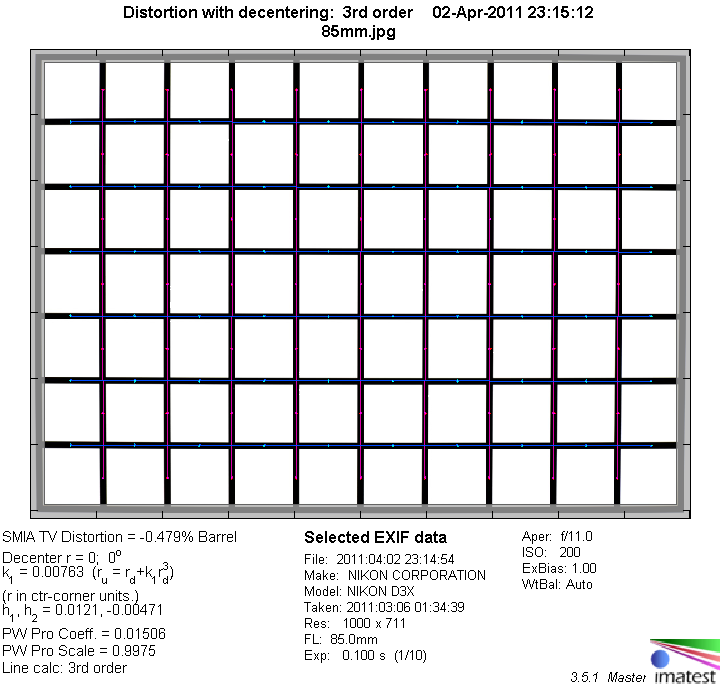|
Page 2 of 3

Distortion
The lens shows a small amount of barrel distortion that is hardly field-relevant.

The chart above has a real-world size of about 120x80cm.
Vignetting
Fast lenses tend to suffer from high vignetting on full frame cameras and the AF-S 85/1.4 is no exception to this rule. Wide open the corners darken visibly with a maximum light fall-off of almost 1.8 EV. Stopping down helps to reduce vignetting, but even at f/2 the amount of light falloff remains on a level that can be disturbing. From f/2.8 onwards vignetting is no longer field-relevant, except for really critical scenes.
We're performing our vignetting analysis based on
(uncorrected) JPEGs straight from the camera. The JPG engine of the Nikon D3x features a rather flat
gradation curve, thus has a moderate contrast characteristic, resulting in comparatively low vignetting figures - the
corresponding Canon figures are roughly 40% higher due to the more
aggressive default contrast setting.

MTF (resolution)
The center resolution is excellent straight from the maximum aperture and reaches extremely high figures stopped down to f/4.
Borders and corners follow a bit behind with very good resolution wide open. Stopping down helps to increase the resolution to excellent sharpness from f/4 onwards.
For such a fast lens this is an impressive performance. Unfortunately there is one issue that spoils the party a little bit: the lens showed a slight amount focus shift when stopping down (residual spherical aberration).
Please note that the MTF results are not directly comparable across the different systems!
Below is a simplified summary of the formal findings. The chart shows line widths
per picture height (LW/PH) which can be taken as a measure for sharpness.
If you want to know more about the MTF50 figures you may check out the corresponding
Imatest Explanations

Chromatic Aberrations (CAs)
Chromatic aberrations (color shadows at harsh contrast transitions) are well controlled. They reach a maximum amount of 0.9 pixels on the average at the image borders at f/2, but decrease again by stopping down.

Bokeh
One of the primary usage scenarios for a large aperture lens is to seperate the main subject from the background. In such an image the quality of the bokeh (out-of-focus blur) is of major significance.
As you'd expect from a fast portrait lens the quality of background blur is in a very high level. However, there's a tad of nervousness, especially in the transition zone. Stopping down slightly helps to reduce the issue, though.
Thanks to 9 rounded aperture blades, background highlights retain their circular shape throughout the whole aperture range, except towards the image corners. Due to mechanical vignetting they are cut off at one side at wide open and to some degree also at f/2. There is a small amount of outlining and some traces of Bokeh fringing (which is typical for this lens class, see next section).

Bokeh Fringing
Bokeh fringing is a common issue with relatively fast glass. It's visible as halos of different colors in out-of-focus areas - magenta (red + blue) in front of the focus point
and green beyond.
Typical for most fast primes, especially ultra fast ones, the AF-S 85 shows noticeable bokeh fringing at large aperture settings, which can of course be reduced by stopping down.
In addition, these shots also show the focus shift when stopping down, which was mentioned in the MTF section.
|
Move the mouse cursor over the f-stop marks below to observe the respective bokeh fringing
|
| f/1.4 |
f/2 |
f/2.8 |
f/4 |
f/5.6 |
|

|
|